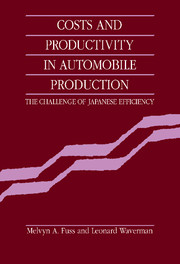Book contents
- Frontmatter
- Contents
- Preface
- Chapter 1 Introduction
- Chapter 2 International differences in output, productivity, and wages in the automobile industry: the 1950s to the mid-1980s
- Chapter 3 The cost-function approach to the analysis of cost and total factor productivity differences
- Chapter 4 Data base sources and method of construction
- Chapter 5 Empirical results: estimation of the cost function
- Chapter 6 Productivity growth in the automobile industry, 1970–1984: a comparison of the United States, Japan, Germany, and Canada
- Chapter 7 International comparisons of automobile industry cost and productivity levels: Japan, Germany, and the United States
- Chapter 8 International comparisons of automobile industry cost and productivity levels: Canadian with U.S., Japanese, and German production
- Chapter 9 Summary and conclusions
- References
- Index
Chapter 5 - Empirical results: estimation of the cost function
Published online by Cambridge University Press: 16 October 2009
- Frontmatter
- Contents
- Preface
- Chapter 1 Introduction
- Chapter 2 International differences in output, productivity, and wages in the automobile industry: the 1950s to the mid-1980s
- Chapter 3 The cost-function approach to the analysis of cost and total factor productivity differences
- Chapter 4 Data base sources and method of construction
- Chapter 5 Empirical results: estimation of the cost function
- Chapter 6 Productivity growth in the automobile industry, 1970–1984: a comparison of the United States, Japan, Germany, and Canada
- Chapter 7 International comparisons of automobile industry cost and productivity levels: Japan, Germany, and the United States
- Chapter 8 International comparisons of automobile industry cost and productivity levels: Canadian with U.S., Japanese, and German production
- Chapter 9 Summary and conclusions
- References
- Index
Summary
The cost function was estimated using annual pooled three-digit automobile production data from Canada (1961–84), United States (1961–84), Japan (1968–84), and Germany (1961–81). A detailed description of the data was presented in Chapter 4.
However, there is one variable, output, whose construction must be discussed in some detail because of the substantial bias that can result when the normal procedures are applied in the context of international comparisons. The output used in the estimation is real gross output, where the various physical outputs are aggregated using real comparative wholesale prices as weights. The procedure of using prices (rather than the theoretically correct marginal costs) as aggregation weights imparts a bias to the calculation of real comparative outputs when markups differ across the outputs being aggregated, and when the mix of outputs being produced differs among countries. Calculation of the bias requires a detailed knowledge of production, wholesale prices, and markups. We have this data for a major portion of output for one year (1979), and can calculate the magnitude of the bias for that year. Table 5.1 contains the information required for the automobile-production portion of output. Note the very different mix of production in the U.S., Japan, and Germany, as well as the difference in markups for different categories of automobiles. The distribution of production in Canada is sufficiently similar to the distribution in the United States that the bias imparted to U. S. –Canada comparisons in 1979 is negligible.
Information
- Type
- Chapter
- Information
- Costs and Productivity in Automobile ProductionThe Challenge of Japanese Efficiency, pp. 116 - 130Publisher: Cambridge University PressPrint publication year: 1992
